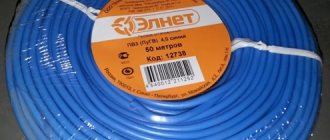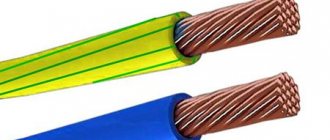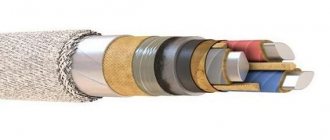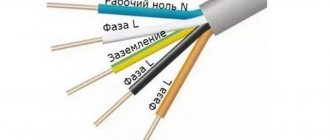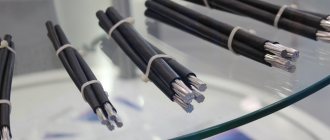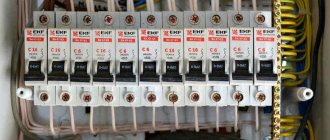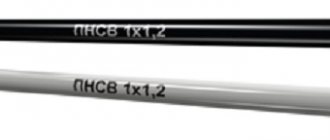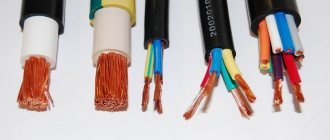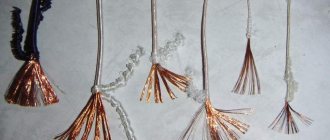Wire PuGV 1x6 is a power installation cable; a conductor consisting of several wires made of copper is used as a conductive element. The insulating layer is represented by PVC compound with various pigmentations. The shades used are white, blue, yellow-green, brown, red, gray, blue, black.
The product is standardized by state standard 31947-2012. In OKPO it has code 355113.
Navigation
- Decoding
- Features and Benefits
- Application
- Wire design
- Specifications
- How much does it weigh?
- Price
- Wire installation
Return to navigation
Features and Benefits
The modern range of wires is represented by high-quality products with such advantages as ease of installation, reliability during operation, etc. It is these properties that characterize PuGV 1x6. Currently, the cable is most widely used in the construction of power transmission lines and communication networks. The advantages of the wire also include increased flexibility and durable PVC insulation. During installation, direct exposure to ultraviolet radiation on the cable should be avoided.
To facilitate the work of electricians, various options for painting the product are provided. This eliminates confusion when laying multiple wires, repairing and replacing them. When constructing complex networks, this advantage is the most significant. All manufacturing plants have their own color spectrum of polyvinyl chloride coating, because... regulatory documents have no restrictions on their design. Most often, the wires are solidly colored in one shade, with the exception of the yellow-green cable, in which the yellow and green stripes are arranged diametrically. This provides additional convenience when indicating grounding. The zero phase is most often laid with a blue cable.
PuGV 1x6 wire should be stored in closed warehouses that exclude exposure to ultraviolet radiation and high humidity.
The resistance under normal conditions is 1 MOhm/km when accepting work and transporting the product, and 0.01 MOhm when working and in warehouses.
PuGV 6 is wound on a drum or assembled into a bay. The standards do not provide requirements for the diameter of the auxiliary unit for transportation. Behind the scenes, drums and couplings with a winding element with a diameter equal to ten outer diameters of the cable are used. These elements contain a tag with information about the manufacturer, cable designation, product length, gross weight in kg (drums), production time and regulatory support.
Return to navigation
Power wire PV3 (PuGV) 1x6 yellow-green multi-wire (flexible)
Purpose:
The installation wire PuGV is intended for stationary installation in enclosed spaces and under a canopy (in the absence of direct exposure to solar radiation and precipitation) in lighting and power networks, as well as for installation of electrical equipment, machines, mechanisms and machine tools with a rated voltage of up to 450 V (for networks 450/750 V) with a frequency of up to 400 Hz or constant voltage up to 1000 V, mainly for areas where wire bends are possible.
Produced in accordance with GOST 6323-79.
OKP code 355113.
Subject to mandatory certification in the Russian State Standard system.
Description and design of the PuGV wire:
Installation wire PuGV is a wire with one flexible copper core, with PVC insulation, without a sheath.
Explanation of the designation:
absence of the letter “A” at the beginning – copper core;
“Pu” - installation wire;
“G” - for installation conditions requiring increased flexibility;
“B” - PVC insulation, including low fire hazard and heat-resistant;
Designation example: PuGV-2.5 - PuGV wire with a conductor cross-section of 2.5 mm²
Since PuGV installation wires are intended mainly for industrial use and are designed for a long service life, GOST sets strict requirements for finished products in terms of structural, electrical and mechanical parameters. The values of individual parameters are also regulated for the period of operation and storage.
The range of produced cross-sections of PuGV installation wires is from 0.5 to 95 mm².
The cores must be twisted from individual wires (at least 7 wires for sections up to 1.5 mm² inclusive and with the diameter of individual wires for the most used sections not exceeding that indicated in the table).
| Section, mm² | Diameter of individual wire, mm |
| 2,5 | 0,43 |
| 4 | 0,53 |
| 6 | 0,65 |
| 10 | 0,82 |
| 16 | 0,65 |
| 25 | 0,82 |
| 35 | 0,69 |
The insulation must fit tightly to the core and be removed without damaging the core. The nominal and minimum values of the radial insulation thickness and the maximum outer diameter for wires of the most commonly used sections up to 50 mm² are given in the table.
| Nominal cross-section, mm² | Nominal insulation thickness, mm | Minimum insulation thickness, mm | Maximum outer diameter, mm |
| 0,75 | 0,6 | 0,44 | 2,6 |
| 1 | 0,7 | 0,53 | 2,8 |
| 1,5 | 0,7 | 0,53 | 3,1 |
| 2,5 | 0,8 | 0,62 | 3,9 |
| 4 | 0,8 | 0,62 | 4,4 |
| 6 | 0,8 | 0,62 | 4,9 |
| 10 | 1 | 0,8 | 6,4 |
| 16 | 1 | 0,8 | 8 |
| 25 | 1,2 | 0,98 | 9,8 |
| 35 | 1,2 | 0,98 | 11 |
It is allowed to repeat the configuration of the current-carrying core on the insulation surface within permissible deviations.
PuGV wires must be made in various colors. The coloring must be solid or done by applying two longitudinal stripes to the insulation of a natural color, located diametrically. For single-core wires used for grounding purposes, the insulation should be a solid yellow-green color.
The color of solid insulation or longitudinal strips must be specified in the order (the letters indicated in the table are added to the wire designation when ordering, for example: PuGV-2.5 Zh).
| Designation | Color |
| White, natural or gray | B |
| Yellow or orange or purple | AND |
| Red or pink | TO |
| Blue or cyan | WITH |
| Green | Z |
| Brown | Kch |
| Black | H |
| Yellow-green | Z-Z |
If there is no indication of a specific color in the order, the manufacturer supplies wires at its discretion, while it is allowed to supply wires with insulation of transitional and mixed colors (designation “BC”) in a volume of no more than 10% of the batch.
Conditions for installation and operation of the PuGV wire:
Operation is allowed at ambient temperatures from minus 50°C to a temperature at which heating of the cores does not exceed plus 70°C. Installation must be carried out at a temperature not lower than minus 50°C. The minimum bending radius when laying is 5 outer diameters. Does not propagate combustion when laid alone. Service life – at least 15 years.
Technical characteristics of PuGV wire:
The electrical resistance of current-carrying conductors at direct current for wires with a cross-section of up to 50 mm² upon acceptance and delivery must be no more than that indicated in the table. For wires with a cross section of 0.75; 1 and 1.5 mm 2 core resistance depends on the core design.
| Section, mm² | Copper conductor resistance, Ohm/km |
| 0,75 | 24,5-25,5 |
| 1 | 18,1-21,8 |
| 1,5 | 12,1-14,0 |
| 2,5 | 7,41 |
| 4 | 4,61 |
| 6 | 3,11 |
| 10 | 1,99 |
| 16 | 1,21 |
| 25 | 0,809 |
| 35 | 0,551 |
For the period of operation and storage, it is allowed to increase the specified resistance values of the cores by 20%.
The electrical insulation resistance per 1 km of length at a temperature of 20°C must be at least 1 MOhm upon acceptance and delivery and at least 0.01 MOhm for the period of operation and storage.
Upon acceptance and delivery, finished wires must withstand, when immersed in water without preliminary exposure to it, testing with an alternating voltage of 2000 V at a frequency of 50 Hz for 5 minutes, applied between the conductor and water (for the period of operation and storage - 1000 V under the same conditions).
The wires must withstand winding at a temperature of minus 15°C into a cylinder (drum) with a diameter equal to 5 outer diameters of the wire (on a special installation directly in the refrigerating chamber).
Requirements for packaging of PuGV wire:
PuGV wires must be supplied in coils or on drums. The diameter of the coil or the diameter of the drum neck is not regulated, but should not be less than 10 outer diameters of the wire.
The construction length must be at least 100 m. In one delivery lot, no more than 10% of wires with a length of at least 20 m are allowed.
Labeling requirements:
Wires must have the manufacturer's designation and the wire identification, which must be made in the form of a continuous marking on the insulation surface. The marking may be printed, embossed or stamped onto the surface of the wire. The distance from the end of the marking to the beginning of the next one should not exceed 500 mm. It is allowed to mark wires with a cross-section of up to 6 mm² in the form of a distinctive thread or colored stripes or solid marks.
The label attached to the coil or drum, or on the cheek of the drum, must indicate:
— trademark of the manufacturer;
— symbol of the wire (full, indicating the number of cores and cross-section);
— length in meters;
— gross weight (for drums) in kilograms
— date of manufacture (year, month);
— GOST designation.
The label must bear a technical control stamp and a certification mark.
For wires supplied on a drum, the label attached to the coil or drum, or on the cheek of the drum, must indicate the number of sections and their length through a plus sign from the top to the bottom layers in meters.
Requirements for storage conditions of PuGV wire:
According to climatic conditions, wires must be stored indoors.
Weight and size parameters of the PuGV wire:
Approximate weights of the most common wire cross-sections for packaging and transportation purposes are given in the table. The given values may differ for wires of different batches and manufacturers by 10% less or more.
| Section, mm² | Weight value for packaging and transportation purposes, kg/km |
| 0,75 | 12 |
| 1 | 14 |
| 1,5 | 20 |
| 2,5 | 31 |
| 4 | 48 |
| 6 | 70 |
| 10 | 116 |
| 16 | 182 |
| 25 | 287 |
| 35 | 378 |
PuGV wire load currents:
Permissible load currents for wires are not regulated in GOST. In accordance with the PUE, for any installation method it is recommended that for single wires not exceed the load currents indicated in the table.
| Section, mm² | Permissible load current, A |
| 0,75 | 15 |
| 1 | 17 |
| 1,5 | 23 |
| 2,5 | 33 |
| 4 | 41 |
| 6 | 50 |
| 10 | 80 |
| 16 | 100 |
| 25 | 140 |
| 35 | 170 |
Available methods for quality control of PuGV wire:
Control methods are presented that, while not strictly complying with GOST, allow preliminary conclusions to be drawn about the quality of the wire if the measured values differ significantly from the regulated ones. The final conclusion about the compliance of the wire with GOST can be made only after testing the wire in a specialized laboratory using strict methods and in the volumes specified in GOST.
Visual inspection.
The following can be checked: marking, number of wires in the core, color and integrity of the insulation.
Measuring structural dimensions.
The insulation thickness and outer diameter can be checked using suitable measuring instruments. Measuring the wire diameter dpr and calculating the cross-section of the core using the formula 0.785dpr² N (where N is the number of wires in the core) is not a strict method for controlling the cross-section of the cores, because confirmation of cross-section compliance is electrical resistance, however, a significant deviation of the calculated cross-section from the nominal (more than 10%) may serve as a basis for doubts about the quality.
Measuring the electrical resistance of current-carrying conductors.
It can be carried out on the finished wire with an ohmmeter with a suitable measurement limit (with a small cross-section and the normal length of the wire in a coil or on a drum can be several Ohms) and recalculated to a length of 1 km. Particular attention should be paid to making good contact with the test leads.
Application
Wire PuGV 1x6 mm2 is used in non-mobile networks with voltage less than 0.75 kV and frequency less than 0.4 kHz. The product is most widely used when installing power supply systems in lighting and power circuits, as well as when switching devices in power panels.
It is mounted inside steel pipes, boxes, trays, and can be used when constructing highways with increased requirements for cable flexibility.
A single cable does not spread fire.
Return to navigation
Difference from PV-3
PV-3
Wires PV-3, PV-4 and PUGV are analogues. To understand whether there are differences in them, you need to understand their parameters.
PV-3 is a power element used at the declared operating voltage and direct current. Used in cases where increased flexibility of the product is important. It has insulation that is not subject to fire and mold. Withstands temperatures up to 150° C.
The PUGV conductor has minimal differences that allow them to replace PV-3 and PV-4. The main difference is the number of cores. PUGV has 5 cores, which make the cable more flexible. There are also minimal changes in insulation temperature limits and ambient humidity. All changes that have occurred with the cable are associated with changes in GOST, therefore PV-3 and PA-4 are complete analogues.
Wire design
Power wire PuGV 1x6 consists of the following elements:
- A conductive copper core containing several annealed wires. The latter comply with the standards of class I or II of state standard 22483-77.
- An insulating layer made of polyvinyl chloride plastic.
- External covering, material is the same as insulation. Has a placeholder.
The density of the shell allows you to maintain the outline of the core without exceeding the limits of maximum deviations.
Return to navigation
Decoding the brand
GOST R 53768-2010 determined the marking procedure and the symbols used when marking cables. The name contains an alphanumeric code, decoding occurs from left to right.
| Criterion | Content | Designation |
| Product type | Installation wire | Pu |
| Installation cable | Ku | |
| Degree of flexibility | For installations that do not require increased flexibility | Without designation |
| Increased flexibility | G | |
| Sheath and insulation material | Polyvinyl chloride plastic compounds, including low fire hazard and heat-resistant | IN |
| Halogen-free polymer compositions | P | |
| Fire safety performance | Flame retardant when installed individually | Without designation |
| Flame retardant when laid in groups, with reduced smoke and gas emission (category A, B, C, D) | ng(A)-LS ng(B)-LS ng(C)-LS ng(D)-LS | |
| Flame retardant when laid in groups with reduced smoke and gas emissions, with low toxicity of combustion products | (A, B, C, D)LSLTx | |
| Non-flammable during group installation and non-emission of corrosive gaseous products during combustion and smoldering - ng(A, B, C, D) | ||
| Non-flammable when laid in groups and non-emitting corrosive gaseous products during combustion and smoldering, with low toxicity of combustion products | ng(A, B, C, D)- HFLTx | |
| Hyphenated climate control | Moderate climate, operating temperature up to -25 0C | U |
| Cold areas, up to -40 0С | UHL | |
| Dry or humid tropical climate provides resistance to fungal and mold spores | E | |
| Standard size | Number and nominal cross-section of cores | Digits Xdigits |
For example, the designation PuGVngHFLTx-T 1x10.0 shows:
- Installation wire, increased flexibility, modified polyvinyl chloride insulation;
- PVC plastic additives provide additional beneficial properties. Plastic does not support fire when working in a group, smoldering does not cause the release of aggressive gases or toxic hazardous products;
- Tropical production will protect against the decomposing influence of mold in damp and warm rooms;
- A single strand of stranded copper wire, cross-section rated 10.0 mm2.
The PuV wire differs in the design of the current-carrying core. Monolithic, consisting of one wire, the cross-section of which corresponds to the standard. Compared to PuGV, it has very high rigidity.
Specifications
The high technical characteristics of PuGV 1x6 wire and its advantages increase the popularity of the product.
| weight of wire PuGV 1x6 | 0.074 kg/m; |
| uptime | 20 years from the date of issue; |
| fire resistance class | O1.8.2.5.4; |
| during prolonged heating, the core temperature | maximum +70 C; |
| cable deflection radius | minimum 23.5 mm; |
| outer diameter PuGV 1x6 | 4.7 mm; |
| installation temperature | minimum -15 C; |
| operating humidity | maximum 98%; |
| operating temperature | from -50 C to +65 C; |
| climatic parameters | UHL, category 2 according to standard 15150-69. |
The main current loads of the cable include:
| current strength | 59 A; |
| resistance | 3.06 Ohm/km; |
| voltage | 0.75 kV. |
Return to navigation
Differences between PV-3 and PuGV
Explanation of the name of the PuGV wire
The markings differ from each other only in that they are described in different GOSTs, one of which is outdated. Therefore, PV-3 and PuGV are the same wire, having different names. The first is described in GOST 6323-79, which has already been abolished. The second one replaced it, its characteristics are included in GOST R 53768-2010. The main difference between PuGV wire and PV-3 can be considered the higher flexibility class (fifth), which appeared in the new PuGV. PV-3 is becoming less and less common in stores, due to the fact that it is no longer produced by enterprises.
PVC has received additional abrasion resistance, which allows this wire to be used in some movable structures for short periods of use.
Price
The price of PuGV 1x6 wire is set individually for each consumer. The purchase of goods can be made from the available assortment or by pre-order. Advantageous offers and affordable wire prices allow you to choose the product you need. The price per meter is set depending on the volume of the order, the terms of delivery of the goods and other nuances.
To buy PuGV 1x6, just leave a request in a convenient way - on the website or send it by email. In the shortest possible time, the consumer will receive a favorable offer, discounts on purchases and terms of delivery of the order.
Full information about the product, a certificate of conformity, as well as a quality certificate are provided to each buyer without fail, which guarantees the purchase of an original product with the declared characteristics and quality.
Return to navigation
Stages of selecting PuGV wires
It is also interesting that the standards provide for separate stages for wire acceptance.
These rules are quite simple and can be used by private individuals:
| First of all, the rules recommend that we inspect the wire. In this case, you should make sure that the wire cross-section is correct, its design is correct and there are no visible defects. |
| Scheme for measuring core resistance with a single bridge | The next step is to determine the electrical resistance of the conductive wires. Regulatory documents require this to be done using the above and similar diagrams. But in private, you can simply use an ohmmeter. |
| After this, electrical tests of the wire insulation are performed. To do this, insulation resistance is measured and high-voltage tests are carried out. As we noted above, the test voltage for the wire should be 2500V. |
| All wires must be marked accordingly. It must indicate the type of wire, manufacturer's mark, core cross-section and year of manufacture. In this case, this marking must be applied every 550 mm along the wire insulation. |
| But the price of a coil of wire should include the presence of a special label. It must indicate the manufacturer's mark, wire brand, date of manufacture, wire weight, length and conformity mark. |
Wire installation
Using a power line from a PuGV cable is possible at ambient temperatures above -50 degrees. During operation of the network, it is necessary to prevent overheating of the core, which occurs after +70 degrees. The construction of the main line is possible at temperatures above -15 degrees.
When laying a main line in an open area, it is recommended to use protective structures for the wire. Such protective devices include plastic or metal pipes, boxes, trays that prevent the effect of ultraviolet radiation on the surface of the cable.
The wire is most widely used when installing electrical circuits located behind protective material - plaster, facing materials, such as tension and suspended structures. It is also possible to install the cable in a brick wall or monolithic concrete.
Transportation and storage
Transportation and storage of wires and cords must comply with GOST 18690-2012.
Transportation and storage conditions regarding exposure to climatic factors must comply with GOST 15150 group 8.
Transportation conditions in terms of exposure to mechanical factors must comply with group Zh according to GOST 23216.
Warranty period - 3 years. The warranty period is calculated from the date of putting wires and cables into operation, but no later than 6 months from the date of manufacture.
Methods of inspection and product quality
The products can be checked using an external inspection, on the basis of which a preliminary assessment of the condition of the PuGV cable is made if the measured values and parameters are in doubt.
When determining electrical resistance, the contact point of the test leads must be properly checked. It is possible to determine the specific resistance of the cable. A unit of conductor is measured with further calculation for the entire length.
The final conclusion about the quality status is obtained after laboratory tests. However, the cable has several advantages that allow it to be used quite widely with a guarantee and high reliability.
